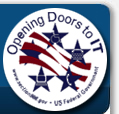Section 508 Roles - EIT Professional
See Also: Tech Tools, How do I evaluate My Software Applications or Website for Accessibility? and Help Desk Questions and Answers.A person who develops, procures, maintains, services, or uses electronic and information technology (EIT) can at some given point be considered an EIT professional. In particular, conformance to the Section 508 Standards presents many challenges for the web developer or content manager. Every document or line of code written must adhere to the standards set for users who fall into the Section 508 categories. The good news is that there are ample resources here and throughout the web on standards, tips, and techniques for delivering dynamic and informative 508 conformant content and websites.
Below are some of the tasks an EIT Professional may need to do with links to resources on how to complete them.
- Assess and evaluate software or website for conformance to the Standards*
- Code site to assist users using assistive devices*
- Learn which types of technology apply to the 508 Standards
- Learn how to make Word, PDF, and PowerPoint documents accessible
- Understand how people with disabilities use the web*
*The World Wide Web Consortium (W3C) http://www.w3.org
Other Useful Information for EIT Professionals:
Access Board Training
Section 508 Tutorial: Developing Accessible Software
Accessibility at Google I/O 2011
Resources available on practical web design accessibility tips.
GSA 508 Tutorials, Guidance , Checklists
Lots of "How to" guidance for making documents accessible.
Microsoft's New free Accessibility Tools and Training for Developers
the immediate availability of Microsoft Accessibility Tools & Training, a package of free online accessibility training courses, tools and other resources to help developers worldwide create technology products, services and websites that are accessible to people with disabilities, and to enable business leaders to make more strategic technology decisions.
Mobil Apps and how to develop Them
Just like all government information, content delivered on mobile devices must comply with general Web policies and requirements, as well as guidance specific to mobile platforms.
Observing Users who Work with Screen Readers
To truly meet the needs of all users, it is not enough to have guidelines that are based on technology. It is also necessary to understand the users and how they work with their tools. For example, just realizing that vision-impaired users do not listen to the entire page is critical for designing usable pages for them. In this paper, you will find guidelines for bringing accessibility and usability together based on observing, listening to, and talking with blind users as they work with Web sites and their screen readers.
Resources for Software Developers
SSA Accessibility Best Practices Library (HTML Coding Examples) , SSA Alternative Text Guide, SSA Accessible Document Authoring Guide , SSA Paper Prototype Accessibility Checklist
Web Development Bookmarklets
These bookmarklets let you see how a web page is coded without digging through the source, debug problems in web pages quickly, and experiment with CSS or JS without editing the actual page.
Web Manager University
Practical and affordable training for anyone who works on a federal, state, tribal, local, or territory U.S. government website.
WebAIM
Contains a host of information on getting starting for accessible design, training and solutions for education, government and business.
Web-based tool to create captioning and subtitles
Universal Subtitles gives individuals, communities, and larger organizations the power to overcome accessibility and language barriers for online video. The tools are free and open source and make the work of subtitling and translating video simpler, more appealing, and, most of all, more collaborative.
WebContent.gov
Hosts Web Manager University, and the Web Content Managers Forum. Contains how to’s on requirements and best practices, usability and design.

